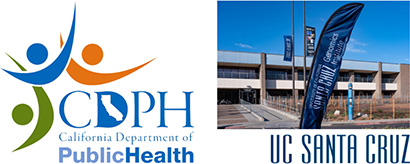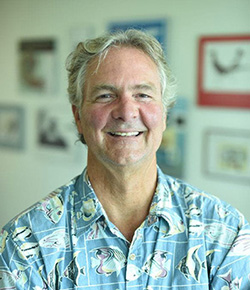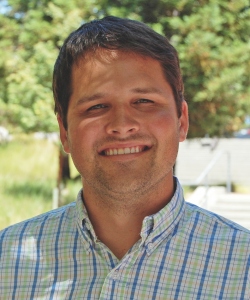UC Santa Cruz is drawing on its expertise in genomics and data sharing to lead a new, state-sponsored public health program. In an agreement signed August 18, 2021, UCSC will develop tools designed to benefit California residents by overlaying SARS-CoV-2 genomic data with public health information.
This approach will let public health officials use genomic data to identify how a virus evolves, and then where and when its variants spread in an outbreak. This undertaking promises to help the state contain the spread of viruses like SARS-CoV-2, the virus that causes COVID-19, by rapidly and accurately changing public health policies and practices to control the spread of infection.
UCSC’s strength in bioinformatics—an interdisciplinary field that develops methods and software for understanding complex biological datasets—will be tapped to fuel a pathogen genomics program, a specialization set to become a cornerstone for tackling future outbreaks of communicable disease.
A pathogen genomics program analyzing the genetic codes of dangerous viruses, bacteria, or other microbes in our community offers public health officials a powerful tool to help prevent outbreaks. The field of pathogen genomics has risen to unprecedented prominence during the pandemic as public health experts scramble to translate SARS-CoV-2 DNA data into public policy.
“We expect the impact of this work to last far beyond the current public health crisis,” explained UCSC Assistant Professor of Biomolecular Engineering Russ Corbett-Detig, who is a co-principal investigator for UCSC’s contract.
UCSC has long been a leader in genomics, and has demonstrated a strong public commitment to data sharing dating back to its involvement in the Human Genome Project twenty years ago, when then graduate student Jim Kent and his mentor David Haussler assembled and published the draft human genome to the internet for free. Kent and fellow UCSC researchers went on to create the UCSC Genome Browser, a free search engine that allows researchers to peer into the details of genetic code.
The Browser has since become a staple for molecular research. With each new global outbreak of infectious diseases, a growing section of the Genome Browser has become dedicated to the genomes of dangerous pathogens.
“When there has been an urgent, international epidemic situation, we’ve stepped in and used our capabilities of building genome browsers to help with it,” said Haussler, who now serves as the Scientific Director of the UC Santa Cruz Genomics Institute.
When COVID-19 reached Santa Cruz in early 2020, a group of UCSC professors converted a research space into a COVID-19 testing site and sidelined their main research to help with local testing and sequencing efforts. The testing lab has since become foundational to UCSC’s strategy to help the greater Santa Cruz community stay ahead of the pandemic and keep it at bay.
Key components of the platform that UCSC will deliver to the state are: the testing lab, now proven in its ability to deliver fast, accurate test results; a growing team dedicated to sequencing the positive cases; the Virus Browser itself; and a new Browser feature designed to maximize its ability to visually display the ocean of genomic data the lab generates. Those responsible for delivering the platform are UCSC faculty members David Haussler, Russell Corbett-Detig, and Professor of Ecology and Evolutionary Biology A. Marm Kilpatrick.
Corbett-Detig is particularly excited about the Browser feature that allows an epidemiologist, using their own secure computer, to view public health information visually overlaid on an evolutionary—or phylogenetic—tree inferring how genomes were transmitted from one person to another.
“One of the things that the phylogenetic tree can do is to create a link between cases that weren’t obviously connected,” says Corbett-Detig. “That tells us something about the likely source of infection and so who to follow up with first for contact tracing.”
Haussler stresses that to do this, the UCSC team will not be using patient information, just virus genomes. But the program will allow public health experts to use virus genomes to track who is catching the virus and how. With the help of Corbett-Detig’s analysis, health officials in Marin County were recently able to trace transmission from a teacher to more than half of their class, as reported in the New York Times (“How the Delta Variant Infiltrated an Elementary School Classroom”) and numerous other news outlets.
While ensuring its tools are both effective and secure, the team will deliver a final product designed to help shepherd California out of the current pandemic.
Corbett-Detig noted that the shelf life of the program will extend beyond COVID because it can prepare us for future pandemics, and it can help public health efforts on well known infectious diseases such as tuberculosis.
“The software can work on just about any pathogen,” he asserts.






